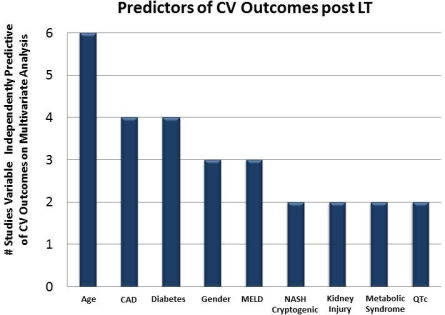Incidence of and Risk Assessment for Adverse Cardiovascular Outcomes Following Liver Transplantation: A Systematic Review.
1Hepatology, Univ of Michigan, Ann Arbor, MI
2Transplantation Surgery, Univ of Michigan, Ann Arbor, MI
3Cardiology, Univ of Michigan, Ann Arbor, MI.
Meeting: 2016 American Transplant Congress
Abstract number: C225
Keywords: Liver transplantation, Outcome, Risk factors, Vascular disease
Session Information
Session Name: Poster Session C: Liver Transplantation Complications and Other Considerations
Session Type: Poster Session
Date: Monday, June 13, 2016
Session Time: 6:00pm-7:00pm
 Presentation Time: 6:00pm-7:00pm
Presentation Time: 6:00pm-7:00pm
Location: Halls C&D
Purpose: Cardiovascular (CV) events remain a major source of morbidity and mortality following liver transplantation (LT). This review evaluates the incidence of and risk assessment for adverse CV outcomes following deceased donor adult liver transplantation.
Methods: MEDLINE via PubMed was searched for studies published between January 2002 and December 2015 (MELD era) with the assistance of a research librarian. Two authors independently reviewed articles to select eligible studies.
Results: Twenty-three studies were included, all retrospective analyses. Sixteen evaluated overall risk factors for CV outcomes following LT; 7 evaluated different forms of CV imaging for risk stratification. In total, 5604 patients from 15 unique cohorts, and 1943 from 7 unique cohorts were represented in the two categories respectively. Studies were heterogeneous with respect to definition of CV outcomes and follow-up duration. The incidence of CV outcomes <6 months post LT ranged from 7-41.6% whereas the incidence of CV outcomes >1 year post LT ranged from 3.9-28% (range 1-8.2 years). For combined CV outcomes, age at time of LT, history of coronary artery disease (CAD), and history of diabetes were the most consistent independent predictors of CV outcomes post LT on multivariate analyses  . Studies focused on cardiac imaging demonstrated discordant results regarding sensitivity, specificity, and predictive value of dobutamine stress echocardiography, cardiac angiography and nuclear testing (SPECT) for predicting CV outcomes post LT.
. Studies focused on cardiac imaging demonstrated discordant results regarding sensitivity, specificity, and predictive value of dobutamine stress echocardiography, cardiac angiography and nuclear testing (SPECT) for predicting CV outcomes post LT.
Conclusions: Although limited by heterogeneity across studies, several variables were consistently identified as being independently predictive of CV outcomes following LT. Existing data are conflicting regarding the predictive value of various cardiac testing modalities for CV events post LT. Future prospective studies are needed to assess different risk stratification approaches and their effectiveness in optimizing CV outcomes post LT.
CITATION INFORMATION: Konerman M, Fritze D, Weinberg R, Spengler E, Sonnenday C, Sharma P. Incidence of and Risk Assessment for Adverse Cardiovascular Outcomes Following Liver Transplantation: A Systematic Review. Am J Transplant. 2016;16 (suppl 3).
To cite this abstract in AMA style:
Konerman M, Fritze D, Weinberg R, Spengler E, Sonnenday C, Sharma P. Incidence of and Risk Assessment for Adverse Cardiovascular Outcomes Following Liver Transplantation: A Systematic Review. [abstract]. Am J Transplant. 2016; 16 (suppl 3). https://atcmeetingabstracts.com/abstract/incidence-of-and-risk-assessment-for-adverse-cardiovascular-outcomes-following-liver-transplantation-a-systematic-review/. Accessed December 18, 2025.« Back to 2016 American Transplant Congress
